This article was co-authored by Ni-Cheng Liang, MD and by wikiHow staff writer, Sophia Latorre. Dr. Ni-Cheng Liang is a board certified Pulmonologist and the Director of Pulmonary Integrative Medicine at Coastal Pulmonary Associates affiliated with the Scripps Health Network in San Diego, California. She also serves as a Voluntary Assistant Professor of Medicine at the University of California San Diego School of Medicine while volunteering for the UCSD Medical Student-Run Free Clinic for uninsured patients. With over 15 years of experience, Dr. Liang specializes in pulmonary and respiratory medical concerns, mindfulness teaching, physician wellness, and integrative medicine. Dr. Liang received her Doctor of Medicine (MD) from the University of Maryland School of Medicine. Dr. Liang was voted as a San Diego Top Doctor in 2017 and 2019. She was also awarded the 2019 American Lung Association San Diego Lung Health Provider of the Year.
There are 14 references cited in this article, which can be found at the bottom of the page.
This article has been viewed 33,903 times.
An incentive spirometer, or breathing exerciser, is a medical device that can help you breathe fully and deeply to open up the air sacs in your lungs.[1] This device expands the lungs and is often used after surgery or in patients with lung disorders, like COPD or pneumonia, to keep the lungs active, healthy, and clear.[2] Using an incentive spirometer is easy to do, and the device can be used both in the hospital and at home to improve your lung function.
Steps
Setting up the Device
-
1Put the incentive spirometer together, if necessary. If you haven’t used the device before, you may need to assemble it. Wash your hands, then remove the pieces from the plastic bags. Stretch out the flexible tubing with the mouthpiece, then connect the side without the mouthpiece to outlet. The outlet is on the bottom right-hand side of the base.[3]
-
2Position the marker to the recommended level, if applicable. The large column on the outside of the device has a marker, slider, or “coach indicator” that tells you how deeply you should breathe. Generally, your doctor will set this slider for you or let you know what level it should be set at.[4]
- As you breathe into the device, a piston or ball inside the column moves upward to reach the marker.
Advertisement -
3Stand or sit upright before using the device. You should be positioned upright when using the incentive spirometer so that your lungs can expand fully. You can sit on the edge of your bed or in a chair, or even stand if you feel comfortable doing so.[5]
-
4Hold the spirometer at eye level with the base parallel to the floor. Place the incentive spirometer in your non-dominant hand. Hold it at eye level, close enough that the mouthpiece will comfortably reach your mouth. Make sure the base is level and parallel with the floor.[6]
Breathing into the Device
-
1Exhale and place your mouth around the mouthpiece. Breathe out as you normally would, then use your dominant hand to put the mouthpiece to your lips. Close your lips around the mouthpiece and let your tongue rest in the bottom of your mouth to keep it from blocking the mouthpiece.[7]
-
2Inhale through your mouth until the piston reaches the marker. With the mouthpiece in your mouth, take a slow, deep breath in. There is a yellow piston or ball inside the column that will rise as you inhale. The goal is to make the piston or ball rise to the level indicated by the slider or marker.[8]
- If you can’t inhale deep enough to move the piston or ball to the recommended level, don’t get discouraged. As you continue to use the incentive spirometer, your lung function will improve.[9]
-
3Hold your breath for as long as you can. Once the indicator has reached the desired level, hold your breath for as long as possible. Try to aim for at least 10 seconds. During this time, the piston or ball will slide back down toward the base.[10]
-
4Exhale through your mouth, then rest for a few seconds. After holding your breath as long as you can, slowly exhale through your mouth into the incentive spirometer. You can then remove the mouthpiece and rest for a few seconds.[11]
-
5Repeat 10 times per hour or as often as your doctor recommends. If your doctor has given you specific instructions on how often to use the incentive spirometer, be sure to follow them exactly. Otherwise, aim for using the device 10 times per hour.[12] Don’t forget to rest for a few seconds in between breaths to prevent lightheadedness.[13]
-
6Cough to clear your lungs when you are finished. After using the device the recommended number of times, try to cough a few times. Coughing will help clear any fluid or mucus from your lungs and make breathing easier.[14]
Maintaining the Device and Tracking Your Progress
-
1Clean the mouthpiece after each use or use a new one every 24 hours. If the mouthpiece isn’t disposable, wash it with mild soap and water between uses to disinfect it and prevent the buildup of bacteria. Alternatively, you can use a new disposable mouthpiece every day.[15]
-
2Keep a log of your progress for your doctor, if applicable. In some cases, your doctor may want you to keep track of how much air you’re able to inhale. Track your progress by writing down how far the piston moves upward each time you use the device. There are markings on the column that the piston is housed in that indicate how much air you’ve inhaled in milliliters.[16]
-
3Report dizziness or lightheadedness to your doctor. Stop using the device if you feel dizzy or lightheaded at any point. Rest for as long as necessary, then resume your breathing exercises with the incentive spirometer.Let your doctor know if using the device causes any of these symptoms, and follow their instructions going forward.[17]
Expert Q&A
-
QuestionWhat is a normal reading on an incentive spirometer?
 Ni-Cheng Liang, MDDr. Ni-Cheng Liang is a board certified Pulmonologist and the Director of Pulmonary Integrative Medicine at Coastal Pulmonary Associates affiliated with the Scripps Health Network in San Diego, California. She also serves as a Voluntary Assistant Professor of Medicine at the University of California San Diego School of Medicine while volunteering for the UCSD Medical Student-Run Free Clinic for uninsured patients. With over 15 years of experience, Dr. Liang specializes in pulmonary and respiratory medical concerns, mindfulness teaching, physician wellness, and integrative medicine. Dr. Liang received her Doctor of Medicine (MD) from the University of Maryland School of Medicine. Dr. Liang was voted as a San Diego Top Doctor in 2017 and 2019. She was also awarded the 2019 American Lung Association San Diego Lung Health Provider of the Year.
Ni-Cheng Liang, MDDr. Ni-Cheng Liang is a board certified Pulmonologist and the Director of Pulmonary Integrative Medicine at Coastal Pulmonary Associates affiliated with the Scripps Health Network in San Diego, California. She also serves as a Voluntary Assistant Professor of Medicine at the University of California San Diego School of Medicine while volunteering for the UCSD Medical Student-Run Free Clinic for uninsured patients. With over 15 years of experience, Dr. Liang specializes in pulmonary and respiratory medical concerns, mindfulness teaching, physician wellness, and integrative medicine. Dr. Liang received her Doctor of Medicine (MD) from the University of Maryland School of Medicine. Dr. Liang was voted as a San Diego Top Doctor in 2017 and 2019. She was also awarded the 2019 American Lung Association San Diego Lung Health Provider of the Year.
Board Certified Pulmonologist Normal readings vary from person to person, and they're dependent on your height and gender.
Normal readings vary from person to person, and they're dependent on your height and gender.
References
- ↑ https://www.healthwise.net/osumychart/Content/StdDocument.aspx?DOCHWID=custom.22_144
- ↑ https://www.mskcc.org/cancer-care/patient-education/how-use-your-incentive-spirometer-01
- ↑ https://www.mskcc.org/cancer-care/patient-education/how-use-your-incentive-spirometer-01
- ↑ https://www.mottchildren.org/health-library/abj5949
- ↑ https://www.mskcc.org/cancer-care/patient-education/how-use-your-incentive-spirometer-01
- ↑ https://www.mossrehab.com/upload/docs/MossRehab/PatientsAndVisitors/MossRehab_COVID_Discharge_Patient_Guide.pdf
- ↑ https://my.clevelandclinic.org/health/articles/4302-incentive-spirometer
- ↑ https://my.clevelandclinic.org/health/articles/4302-incentive-spirometer
- ↑ https://kidshealth.org/en/teens/incentive-spirometer.html
- ↑ https://www.gbmc.org/workfiles/ersi/ersi-spirometer.pdf
- ↑ https://elsevier.health/en-US/preview/how-to-use-incentive-spirometer
- ↑ https://www.fairview.org/patient-education/82492
- ↑ https://myhealth.alberta.ca/health/AfterCareInformation/pages/conditions.aspx?HwId=abk9577
- ↑ https://www.uofmhealth.org/health-library/abj5949
- ↑ https://www.drugs.com/cg/how-to-use-an-incentive-spirometer.html
- ↑ https://myhealth.alberta.ca/health/AfterCareInformation/pages/conditions.aspx?HwId=abk9577
- ↑ https://myhealth.alberta.ca/health/AfterCareInformation/pages/conditions.aspx?HwId=abk9577
- ↑ https://medlineplus.gov/ency/patientinstructions/000451.htm
About This Article
To use an incentive spirometer, move to an upright position and place the mouthpiece in your mouth. Inhale through your mouth until the piston inside the column reaches the recommended level, indicated by the marker on the outside of the column. Hold your breath for as long as possible, then exhale through your mouth. Repeat 10 times per hour or as often as instructed by your doctor, resting for a few seconds in between each breath. To learn how to set up the spirometer and for tips on minimizing discomfort while using the device, read on!

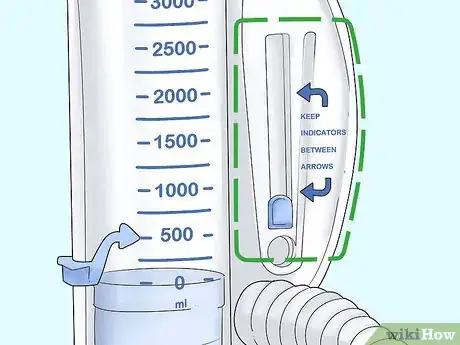



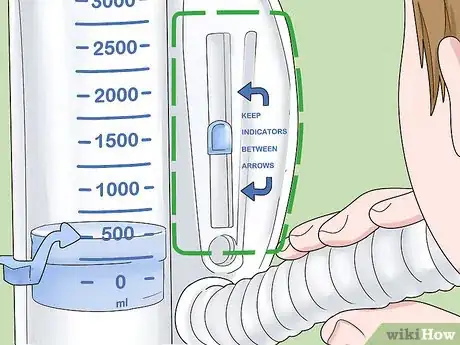
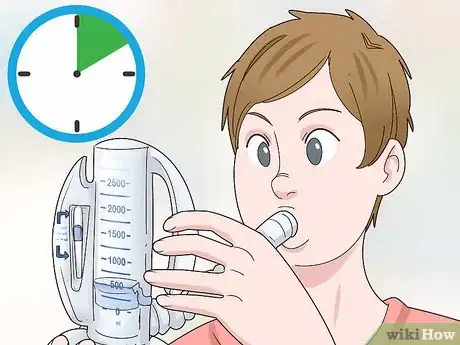

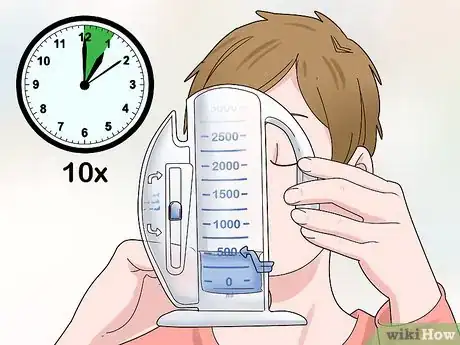


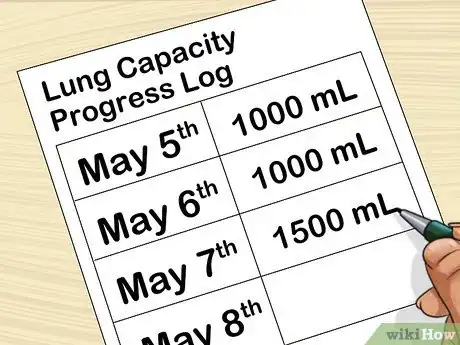

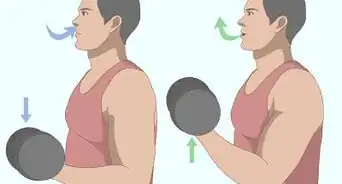
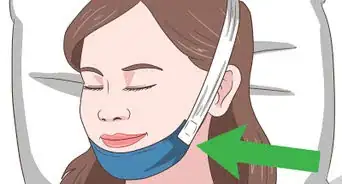





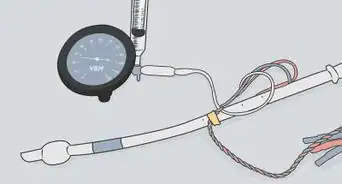




















































Medical Disclaimer
The content of this article is not intended to be a substitute for professional medical advice, examination, diagnosis, or treatment. You should always contact your doctor or other qualified healthcare professional before starting, changing, or stopping any kind of health treatment.
Read More...